Physical Address
304 North Cardinal St.
Dorchester Center, MA 02124
The histopathologic study of infections of the eye and ocular adnexa is a daunting undertaking given the variety of tissues comprising this proportionately small area of the body with extensive exposure to the external environment. Only one previous summary of infections of the eyelid and conjunctiva has been published, but a broader conspectus combining extraocular and intraocular infections is not available. The term adnexa (plural noun, from the Latin adnexus meaning parts that bind together; adnexum is the singular noun) denotes all of the supporting and protecting structures around the eye. Infections may affect any adnexal structure, such as the mucous membrane (conjunctiva), the skin (eyelids), and the orbital contents (lacrimal gland, extraocular muscles, fibroadipose tissue, optic nerve, peripheral nerves and vessels). The cornea (infectious keratitis) shares many of the same susceptibilities as the conjunctiva. Infections can involve the interior of the globe and its layers (infectious retinitis, uveitis, scleritis, endophthalmitis of the vitreous and panophthalmitis of all layers, including the sclera and episclera) either from internal hematogenous spread (endogenous) or from external sources (exogenous), such as trauma or surgery. The clinical presentations and histopathologic findings are unique for each of these sites. They are discussed in the following chapter according to the region primarily harboring the infectious agent.
There are some peculiarities of each ocular structure that determine its response and resistance to infection. For example, the acellular, subepithelial collagenous Bowman layer of the cornea is able to be a temporary barrier against invasion of the corneal stroma, while Descemet membrane often attracts organisms, particularly fungi. The sclera is a poorly vascularized structure that generally does not become infected. The uvea (from the Latin noun uva, meaning grapelike tunic, due to its coloration grossly from resident melanocytes after removing the sclera) which subsumes the iris, ciliary body, and choroid, has a paucicellular fibroblastic component that tends not to proliferate or make scars in response to injury. For example, at the previous site of an infection of the choroid, one can see ophthalmoscopically a white focus that represents the inner aspect of the sclera in the wake of an absence of repair in the choroid. In contrast, the pigment epithelium is able to proliferate floridly and can produce pigmented scars at the edge of an infectious nidus and even undergo fibrous metaplasia with collagen synthesis, a true anomaly in view of the neuroectodermal origin of this tissue. The retina lacks fibroblasts throughout and therefore reaction and healing are glial, in the form of fibrous astrocytic proliferations.
A caveat should be offered: many biopsies for identification of offending pathogens, especially of fungi, may be altered in their morphology by ongoing topical and systemic therapy. These changes include shifts in tinctorial properties, width of fungal hyphae, and other morphologic features.
In medicine we are accustomed to analyzing conditions that simulate one another. Among many such conditions in ophthalmology, there are four that deserve particular attention because they can mimic infectious diseases either clinically or histopathologically.
This inflammatory eyelid disorder, the most common of the eyelids ( Fig. 21.1A , left panel), can easily mislead the general pathologist, because of its granulomatous features, into a diagnosis of a fungal or tuberculous infection (which are ruled out with negative Gomori methenamine silver [GMS] staining or acid-fast staining, respectively). The chalazion originates in the tarsus of the posterior part of the eyelid (almost never the primary site of infection) containing the meibomian glands that produce the lipid for the tear film (see Fig. 21.1A , right panel). Locules of dissolved extracellular fat are surrounded by the epithelioid and giant cells, along with acute and chronic inflammatory cells (a lipogranuloma) (see Fig. 21.1B ). The chalazion represents a blockage in the ducts of the meibomian glands, which may be due to hyperparakeratosis near their orifices, leading to rupture of the glands. Often commencing as an intratarsal bacterial infection, cytoplasmic lipid is eventually released extracellularly to elicit the granulomatous response. Localized xanthogranulomas manifest lipid in the cytoplasm of histiocytes and in the eyelids are mostly xanthelasma, but systemic disorders, such as Erdheim Chester disease and necrobiotic xanthogranuloma, may have eyelid xanthomatous lesions.

This tumor arises in the meibomian and Zeis glands, most often of the upper eyelids in older patients. Because it is capable of spreading within the conjunctival epithelium (“pagetoid extension”), it can create a unilateral red eye ( Fig. 21.2A ), mimicking infectious conjunctivitis. However, bacterial and viral infections are usually bilateral. A biopsy of reddened conjunctiva will reveal large atypical cells with frothy vacuolated cytoplasm (see Fig. 21.2A , top panel) that are androgen receptor and adipophilin positive (see Fig. 21.2B , bottom panel).
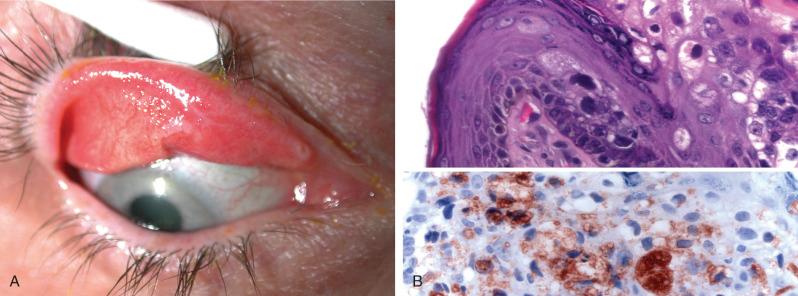
Lymphoma cells involving the retina, vitreous, or iris may seed aqueous of the anterior chamber and settle inferiorly to create a layered pseudohypopyon ( Fig. 21.3A ). Vitreous and aqueous aspirations studied cytologically can reveal the presence of neoplastic cells or polymorphonuclear leukocytes (see Fig. 21.3B ). In these cases the fundus exam may reveal subretinal white, placoid infiltrates (see Fig. 21.3C ). Inflammatory disease (e.g., Behçet) or infections conditions (bacterial endophthalmitis) are often associated with hypopyon, but these typically cause an intensely injected and inflamed eye ( Fig. 21.4A ), whereas a lymphomatous pseudohypopyon is usually encountered in a noninflamed eye. Behçet disease additionally may display retinal vasculitis (see Fig. 21.4B ). Retinoblastoma cells also cause pseudohypopyon in some cases, particularly the diffuse infiltrative form that tends to occur in older children. Imaging studies may reveal diagnostic intralesional calcifications.
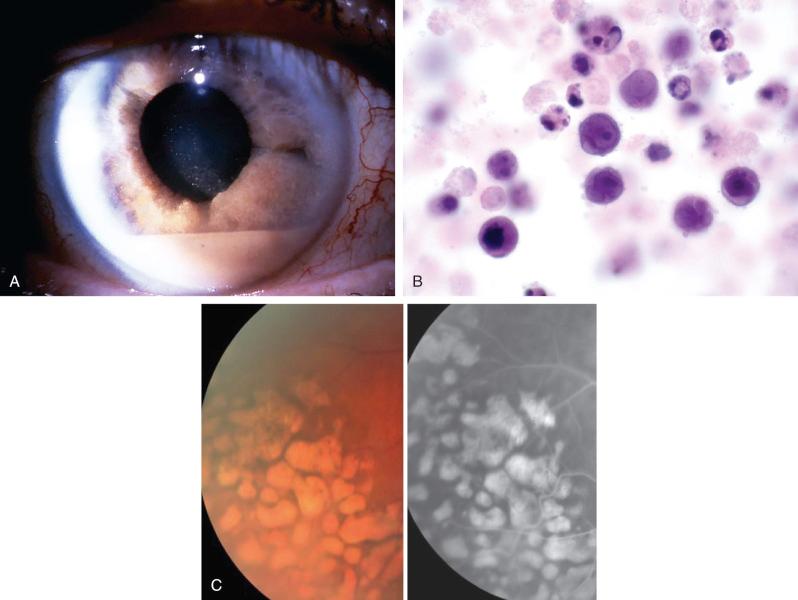
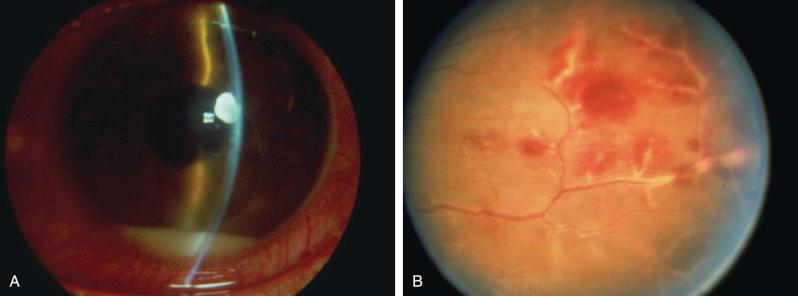
Panophthalmitis (inflammation of all tunics of the eye from retina through sclera into the surrounding orbit) can cause erythema of the eyelids and conjunctival edema with proptosis simulating an infectious orbital cellulitis. Rarely, massive necrosis of a retinoblastoma or uveal melanoma can produce intense periocular inflammation simulating a cellulitis ( Fig. 21.5A ). Imaging studies, especially ultrasound, can help to differentiate these conditions. Histopathology reveals massive spontaneous tumor necrosis that typically involves other intraocular structures (see Fig. 21.5B and C ).
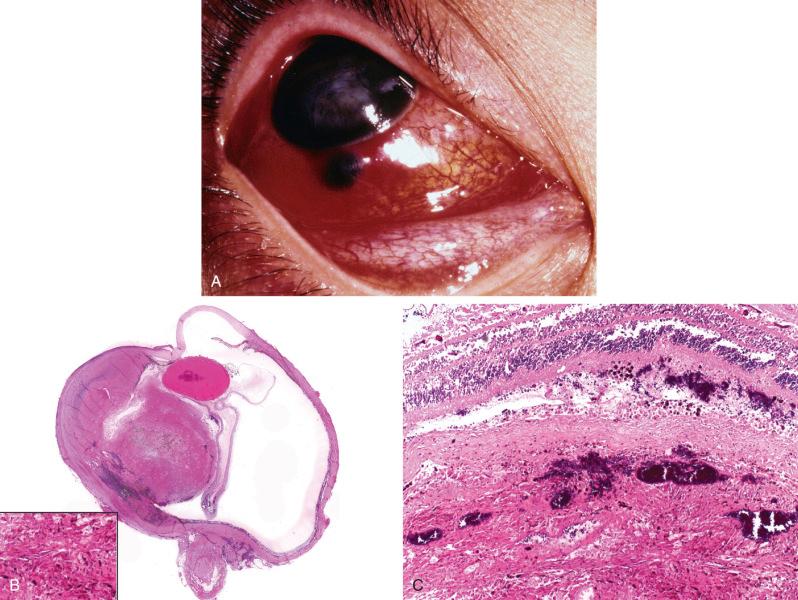
Conjunctivitis is a common ophthalmic condition that is largely infectious in nature. It is often diagnosed solely based on clinical examination. Bacterial conjunctivitis is the most frequent culprit in children; in adults, viral disease predominates. A follicular response (formation of lymphoid follicles histopathologically) is often seen in both cases. Impression or exfoliative cytology can occasionally be helpful in making a specific diagnosis. Biopsy with histopathologic examination is required for comparatively rare diseases, such as fungal conjunctivitis.
Bacterial conjunctivitis shows a predilection for children ( Fig. 21.6A ) and presents with purulent discharge and conjunctival injection, often bilaterally. The most common causative organisms are Streptococcus pneumoniae , Haemophilus influenzae , and Moraxella catarrhalis . In adults, various staphylococcal species predominate as etiologic agents, followed by streptococci and H. influenzae .
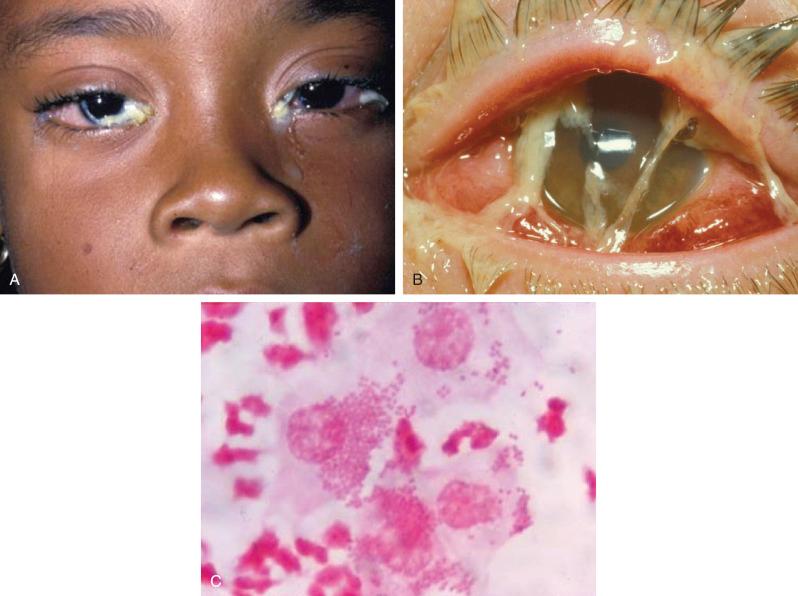
Of special interest is Neisseria gonorrhoeae , an important cause of conjunctivitis in sexually active adults or neonates with direct genital-eye or genital-hand-eye contact. An infected maternal birth canal can cause a dramatic discharge in conjunctivitis neonatorum. Adult patients display a hyperacute presentation with intense purulence (see Fig. 21.6B ). Infected infants and adults should receive oral or intravenous therapy because of the risk of corneal perforation. Conjunctival smears may reveal intracellular gram-negative cocci (see Fig. 21.6C ); swabs sent for culture and polymerase chain reaction (PCR) are confirmatory.
Infections of the sclera are rare (inflammatory scleritis is much more likely to be autoimmune in nature), but such organisms as Pseudomonas may result in necrotizing scleritis with overlying conjunctivitis, especially after surgery; an abscess may form leading to ocular perforation.
Chlamydia trachomatis causes a variety of conjunctivitis syndromes, depending on the serotype. Trachoma (serotypes A to C) is a chronic keratoconjunctivitis that results in severe conjunctival and corneal scarring and is a leading cause of blindness worldwide. More often seen in the Western world is acute chlamydial inclusion conjunctivitis from direct or indirect contact with genital secretions (serotypes D to K which cause genital infections). Patients exhibit a follicular conjunctivitis ( Fig. 21.7A ) but with scant mucopurulent discharge and a relatively chronic course. Giemsa-stained conjunctival smears characteristically reveal many polymorphonuclear cells, with admixed mononuclear and plasma cells. Diagnostic and characteristic cytoplasmic inclusion bodies (so-called Halberstaedter and Prowazek bodies; see Fig. 21.7B ) will be found along with gram-negative intracellular diplococci.
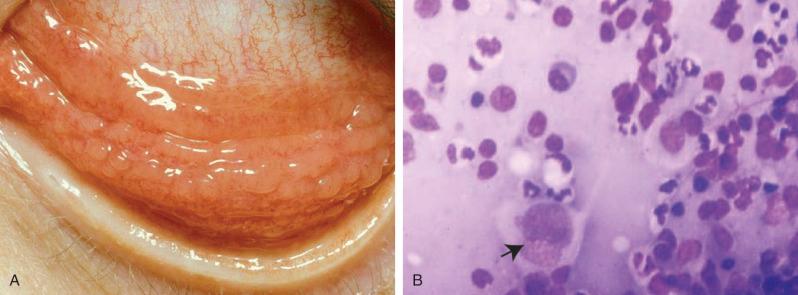
Granulomatous conjunctivitis ( Fig. 21.8A ) with follicle formation and regional lymphadenopathy is known as Parinaud oculoglandular syndrome. The clinical syndrome is most commonly caused by severe non-granulomatous viral conjunctivitis while its granulomatous counterpart is most often a manifestation of cat-scratch disease due to Barontella henselae (and less commonly to tularemia, sporotrichosis, or other Bartonella species). Approximately 5% to 10% of patients developing cat-scratch disease, usually transmitted by a flea-infested kitten, have granulomatous conjunctival involvement. Serologic testing for B. hensalae antibodies or PCR can confirm the diagnosis. Biopsy of conjunctival granulomas (of either the tarsal or bulbar conjunctiva) reveals clumps of slender gram-negative rods, which are also highlighted with the Warthin-Starry silver stain. The infectious agents are often discovered surrounding blood vessel walls (see Fig. 21.8B ). Necrotizing granulomatous inflammation with microabscess formation is a common finding, along with an endothelial cell proliferation (see Fig. 21.8C ). Syphilitic conjunctivitis as a manifestation of secondary syphilis can also rarely cause a granulomatous conjunctivitis ( Fig. 21.9A ). Spirochetes may also be visualized with silver staining of conjunctival tissue (see Fig. 21.9B ).
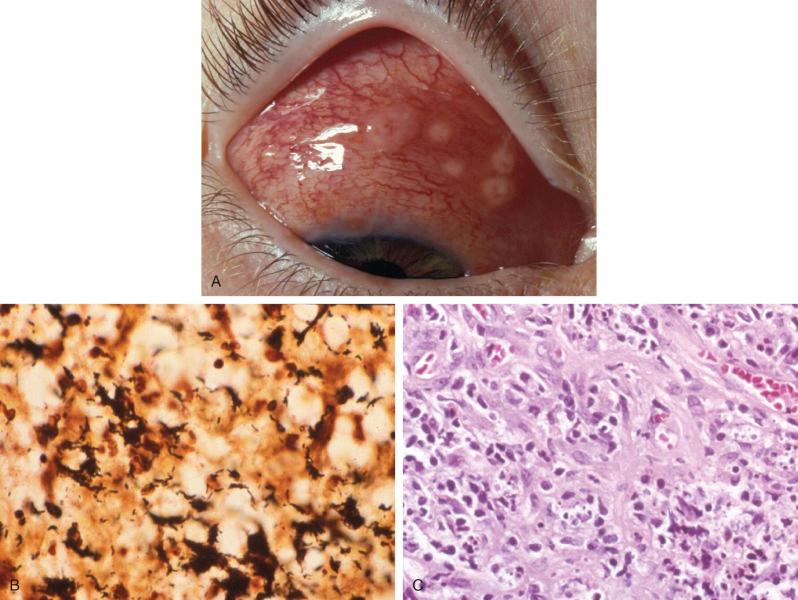
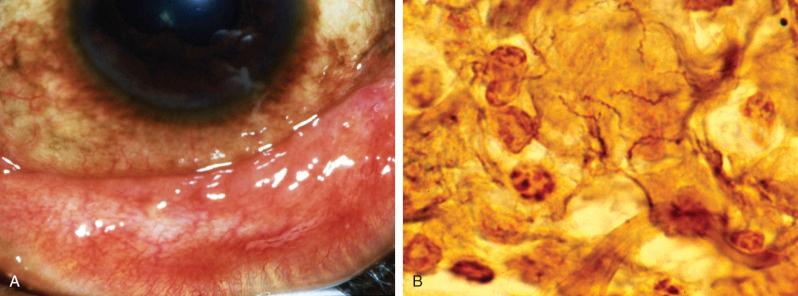
Various serotypes of adenovirus, a double-stranded DNA virus, can cause a simple, self-limited follicular conjunctivitis for which microbiologic or histopathologic examination is rarely performed. Adenoviral keratoconjunctivitis, especially serotype D, is responsible for so-called endemic keratoconjunctivitis or pink-eye infections that spread rapidly through contaminated ocular secretions in populations living or working together. Serotypes 8, 19, and 37 cause bilateral severe follicular conjunctivitis and can coexist with epithelial keratitis. There is prominent accompanying conjunctiva edema (chemosis) and prominent preauricular adenopathy. Later, immunologically mediated multifocal stromal corneal infiltrates often develop. Enterovirus and coxsackievirus infections may cause a contagious hemorrhagic conjunctivitis.
A rapid immunodetection assay is often used to confirm the diagnosis, and PCR can be used to determine the serotype. Conjunctival pseudomembranes can form in cases of endemic conjunctivitis and may need to be peeled from the ocular surface for comfort. Histopathologically the pseudomembranes are composed of fibrin and many polymorphonuclear leukocytes without identifiable organisms. Cytologic preparations of adenoviral conjunctivitis reveal many lymphocytes along with two types of conjunctival epithelial nuclear alterations: intranuclear inclusions and a so-called ground-glass nuclear appearance.
Because herpes simplex virus (HSV) infection is ubiquitous in humans and can infect the trigeminal ganglion, ocular herpetic disease can ensue and is an important cause of ocular morbidity and vision loss due to involvement of various ocular and adnexal sites (these manifestations are discussed later under viral keratitis and viral chorioretinitis). However, primary infection with HSV usually manifests as a unilateral blepharoconjunctivitis. The conjunctivitis is follicular in nature and often associated with a palpable preauricular lymph node and vesicles on the eyelid skin or at the eyelid margin. Ulcers can also develop on the bulbar conjunctiva, which is mildly injected.
HSV conjunctivitis is usually unilateral, as opposed to adenoviral or bacterial conjunctivitis, and, in contrast to the latter's purulent discharge, a watery or slightly mucoid discharge is observed ( Fig. 21.10A ). Conjunctival scrapings and impression cytology of the conjunctiva may reveal characteristic multinucleated epithelial cells (see Fig. 21.10B ). Herpes antigens may be detected from impression cytology specimens. Herpes viruses may also cause chronic scleritis, with nonspecific chronic inflammation of the sclera that is sometimes granulomatous. Immunoperoxidase staining is helpful in identifying the culprit in these unusual cases.
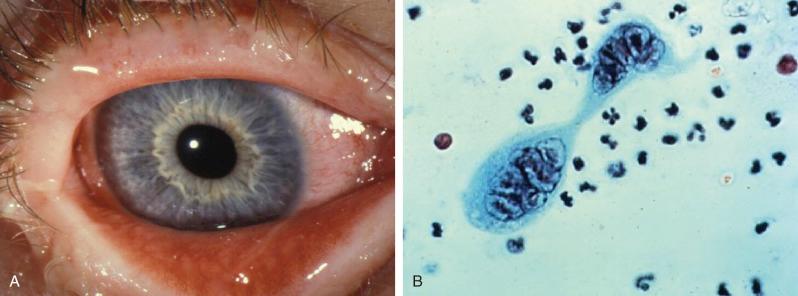
Human papillomavirus (HPV) has been implicated in the development of conjunctival squamous cell carcinoma ( Fig. 21.11 ) in approximately 30% of cases. HPV type 16, as in oropharyngeal and cervical carcinoma, is the most common strain isolated with PCR.
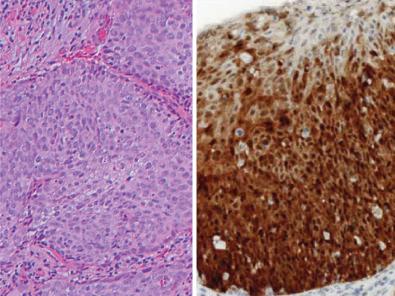
Rhinosporidiosis is caused by infection with the fungus Rhinosporidium seeberi , which leads to the formation of a distinctive highly vascular, polypoidal, or pedunculated mass of the mucous membranes studded with white, subepithelial sporangia ( Fig. 21.12A ). By far the most commonly infected site is the nasal mucosa. Infections are acquired by patients in warm, humid climates; 90% of cases occur in India and Pakistan. Infection probably develops as a result of direct exposure to stagnant water, although inhalation of spores may also play a role. Although rare, the bulbar conjunctiva is the second most commonly involved site of infection. Histopathologically, unique-appearing periodic acid–Schiff (PAS)-positive spherical sporangia of various sizes can be seen within a granulomatous inflammatory background (see Fig. 21.12B ). As the organism matures, eventually reaching approximately 300 µm, a mature sporangium forms a pore through which mature spores (approximately 7 to 10 µm) are discharged (see Fig. 21.12C ). As the life cycle repeats, the characteristic vascular mass grows. Complete excision of the sessile or pedunculated red mass is curative.
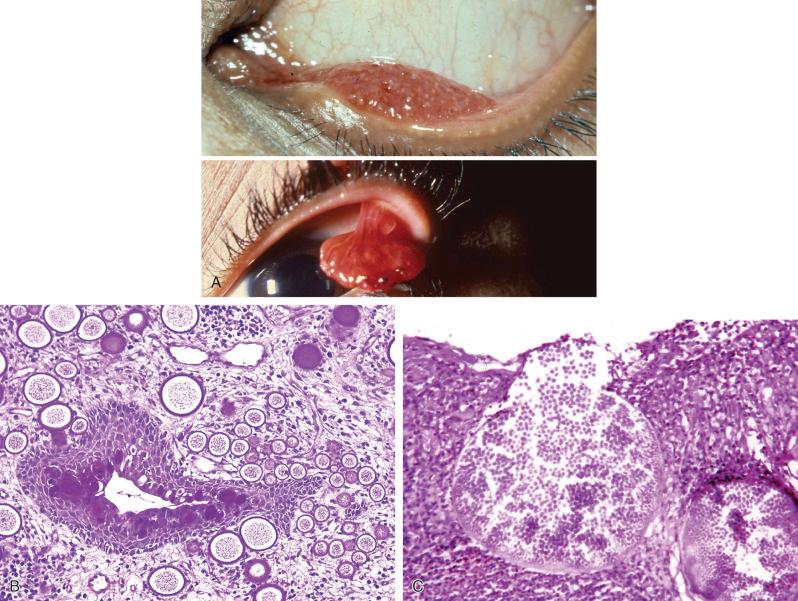
Ocular cryptococcosis, an infection of predominantly patients with human immunodeficiency virus/acquired immune deficiency syndrome (HIV/AIDS), is rare and most commonly manifests in the posterior segment (discussed in further detail under intraocular fungal infections). Atypical cases of anterior segment involvement including conjunctival granulomas simulating squamous cell carcinoma have been reported. Coccidiomycosis, which can cause a fulminant endophthalmitis (also see intraocular fungal infections later), has rarely been described to cause conjunctival or eyelid granulomas. Microsporidiosis of the conjunctiva, initially thought to be a protozoal infection but has been reclassified as a fungal disease, was described in HIV/AIDS patients in the late 1980s and early 1990s as a bilateral, recalcitrant watery conjunctivitis with an associated coarse, epithelial keratitis (see also fungal keratitis later). Conjunctival scrapings for cytology in conjunctival infections reveal numerous large (larger than bacteria) gram-positive, acid fast–positive, Giemsa-positive ovoid organisms within conjunctival epithelial cells and extracellularly. The spores have ultrastructurally been found to measure 2 × 1 µm.
Ocular loiasis is caused by Loa loa , a nematode for which the human is the definitive host. L. loa is endemic in West Africa and is transmitted to humans by infected mangrove (Chrysops) flies that are intermediate hosts for microfilaria. Adult worms migrate through subcutaneous tissues, causing transient pruritic edema, especially in the periocular region; intense peripheral blood eosinophilia and microfilaremia are also seen. The adult worm can be visualized moving through the subconjunctival space ( Fig. 21.13A ), and patients nearly always present with the complaint of a sensation of something moving in or around the eye, mimicking common myokymia. Worms may also rarely be found in the periocular subcutaneous tissues or in the anterior chamber of the eye. The mature worm usually appears many years after initial inoculation and can be surgically removed and examined histopathologically, revealing a tapered head and central esophagus (see Fig. 21.13B ). Systemic treatment is also initiated for microfilaremia.
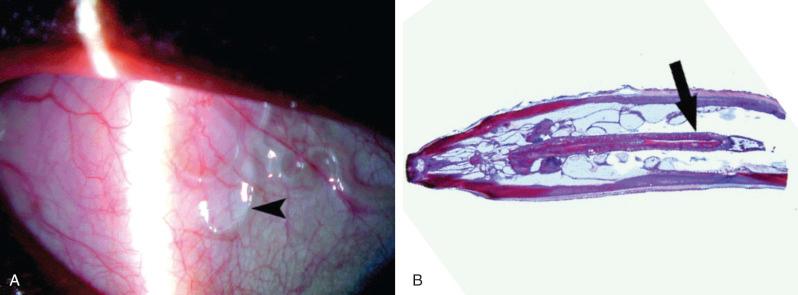
Another nematode, Onchocerca volvulus , also has a tropism for ocular tissues and can rarely be found crawling in the subconjunctival space. Posterior segment chorioretinitis and scarring also contribute to blindness from O. volvulus . This process occurs not due to the migration of live organisms through the cornea but instead to microfilarial death that provokes an intense inflammatory response. Larvae may also be encountered swimming in the anterior chamber. Histopathologically, again, minimal inflammatory response is seen to live microfilariae ( Fig. 21.14 ), but a chronic, nongranulomatous response forms around degenerating organisms . This leads to corneal stromal scarring and vascularization (so-called interstitial keratitis).
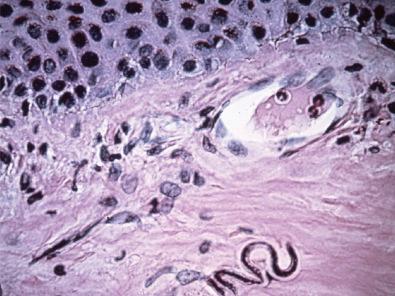
Despite numerous mechanisms in place to prevent infection, including the antibacterial components of the tear film and the mechanical barrier of the rapidly cycling corneal epithelium, a variety of infectious diseases can take up residence within the cornea, especially in susceptible situations with epithelial breakdown. These include chronic exposure, accidental trauma, surgery, trichiasis, and increasingly contact lens wear.
Become a Clinical Tree membership for Full access and enjoy Unlimited articles
If you are a member. Log in here